University of Rochester
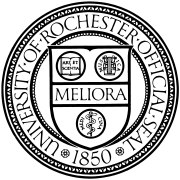 | |
| Latin: Universitas Rocestriensis | |
| Motto | Meliora (Latin) |
|---|---|
Motto in English | Ever Better (also, Always Better) |
| Type | Private, nonsectarian |
| Established | 1850 |
| Endowment | $2.51 billion (2017-2018)[1] |
| President | Richard Feldman (interim)[2] |
| Provost | Robert Clark |
Administrative staff | 1,225 |
| Students | 11,126 |
| Undergraduates | 6,304 |
| Postgraduates | 4,822 |
| Location | Rochester, New York, U.S. |
| Campus | Suburban/Urban, 600 acres (2.4 km2) |
| Colors |
Dandelion Yellow and Rochester Blue[3] |
| Athletics | NCAA Division III – UAA |
| Nickname | Yellowjackets |
| Affiliations |
AAU COFHE NAICU[4] WUN |
| Mascot | Rocky the Yellowjacket |
| Website |
www |
 | |
The University of Rochester (U of R or UR), often simply referred to as Rochester, is a private research university in Rochester, New York.[5] The university grants undergraduate and graduate degrees, including doctoral and professional degrees. In its history, 7 university alumni, 4 faculty, and 1 senior research associate at Strong Memorial Hospital have been awarded Nobel Prizes; 32 faculty serve in the National Academies of Sciences, Engineering, and Medicine; 12 alumni and faculty members have won a Pulitzer Prize, and 20 faculty members have been awarded a Guggenheim Fellowship.[6]
The University of Rochester enrolls approximately 5,600 undergraduates and 4,600 graduate students. Its 158 buildings house over 200 academic majors. Additionally, the university is the largest employer in the Greater Rochester area and the 6th largest employer in New York.[7] According to the National Science Foundation ranking of total research and development expenditures, the University of Rochester spent $346 million on R&D in 2016, the 66th highest figure, nationally.[8]
The University of Rochester is particularly noted for its Eastman School of Music, which ranks first among music schools in the U.S.,[9] [10][11] due to the creative and scholarly contributions of its faculty and students.[12] The Sibley Music Library at Eastman is the largest academic music library in North America and holds the third largest collection in the United States.[13] The Simon Business School is ranked in the top 5 in economics and finance by the Financial Times.[14] Simon faculty founded and support three of the highest-ranked journals in economics and finance: the Journal of Accounting and Economics, the Journal of Financial Economics, and the Journal of Monetary Economics.[15] The School of Medicine and Dentistry is highly regarded nationally[16] and has produced vaccines,[17] drugs,[18] and public health professionals[19] who have saved countless lives. Importantly, the biopsychosocial model of medicine was developed at Rochester, in which physicians aim to treat the whole patient.[20] The Edward G. Miner Library holds numerous significant items, including the Arthur Kornberg Nobel Prize and texts by Andreas Vesalius,[21] among many other medical, scientific, and historical collections.
The College of Arts, Sciences, and Engineering is home to departments and divisions of note. The Institute of Optics was founded in 1929 through a grant from Eastman Kodak and Bausch and Lomb as the first educational program in the US devoted exclusively to optics, awards approximately half of all optics degrees nationwide,[22] and is widely regarded as the premier optics program in the nation.[23] The Departments of Political Science and Economics have made a significant and consistent impact on positivist social science since the 1960s,[24][25] and historically rank in the top 5 in their fields.[26][27] The Department of Chemistry is noted for its contributions to synthetic organic chemistry, including the first lab based synthesis of morphine.[28] The Rossell Hope Robbins Library serves as the university's resource for Old and Middle English texts and expertise.[29] The university is also home to Rochester's Laboratory for Laser Energetics, a US Department of Energy supported national laboratory.[30]
History
Early history
The University of Rochester traces its origins to The First Baptist Church of Hamilton (New York), which was founded in 1796. The church established the Baptist Education Society of the State of New York, later renamed the Hamilton Literary and Theological Institution, in 1817.[31] This institution gave birth to both Colgate University and The University of Rochester. Its function was to train clergy in the Baptist tradition. When it aspired to grant higher degrees, it created a collegiate division separate from the theological division.[32][33]
The collegiate division was granted a charter by the State of New York in 1846, after which its name was changed to Madison University. [34] John Wilder and the Baptist Education Society urged that the new university be moved to Rochester, New York. However, legal action prevented the move. In response, dissenting faculty, students, and trustees defected and departed for Rochester, where they sought a new charter for a new university.
Madison University was eventually renamed as Colgate University.[35]
Founding
Asahel Kendrick, professor of Greek, was among the faculty that departed Madison University for Rochester. Kendrick served as acting president while a national search was conducted. He reprised this role until 1853, when Martin Brewer Anderson of the Newton Theological Seminary in Massachusetts was selected to fill the inaugural posting.[36]
The University of Rochester's new charter was awarded by the Regents of the State of New York on January 31, 1850. The charter stipulated that the university have $100,000 in endowment within five years, upon which the charter would be reaffirmed. An initial gift of $10,000 was pledged by John Wilder, which helped catalyze significant gifts from individuals and institutions.[36]
Classes began that November, with approximately 60 students enrolled, including 28 transfers from Madison.[36] From 1850 to 1862, the university was housed in the old United States Hotel in downtown Rochester on Buffalo Street near Elizabeth Street, today, West Main Street near the I-490 overpass. On a February 1851 visit, Ralph Waldo Emerson said of the university:
'They had bought a hotel, once a railroad terminus depot, for $8,500, turned the dining room into a chapel by putting up a pulpit on one side, made the barroom into a Pythologian Society's Hall, & the chambers into Recitation rooms, Libraries, & professors' apartments, all for $700 a year. They had brought an omnibus load of professors down from Madison bag and baggage... called in a painter and sent him up the ladder to paint the title "University of Rochester" on the wall, and they had runners on the road to catch students. And they are confident of graduating a class of ten by the time green peas are ripe.''[37]
For the next 10 years, the college expanded its scope and secured its future through an expanding endowment, student body, and faculty. In parallel, a gift of 8 acres of farmland from local businessman and Congressman Azariah Boody secured the first campus of the university, upon which Anderson Hall was constructed and dedicated in 1862. Over the next sixty years, this Prince Street Campus grew by a further 17 acres and was developed to include fraternities houses, dormitories, and academic buildings including Anderson Hall, Sibley Library, Eastman and Carnegie Laboratories, the Memorial Art Gallery, and Cutler Union.[38]
Twentieth century
Coeducation
The first female students were admitted in 1900, the result of an effort led by Susan B. Anthony and Helen Barrett Montgomery. During the 1890s, a number of women took classes and labs at the university as "visitors" but were not officially enrolled nor were their records included in the college register. President David Jayne Hill allowed the first woman, Helen E. Wilkinson, to enroll as a normal student, although she was not allowed to matriculate or to pursue a degree. Thirty-three women enrolled among the first class in 1900, and Ella S. Wilcoxen was the first to receive a degree, in 1901.[39] Male students moved to River Campus upon its completion in 1930 while the female students remained on the Prince Street campus until 1955.
Expansion
Major growth occurred under the leadership of Benjamin Rush Rhees over his 1900-1935 tenure. During this time, George Eastman became a major donor, giving more than $50 million to the university during his life.[40] Under the patronage of Eastman, the Eastman School of Music was created in 1921. In 1925, at the behest of the General Education Board and with significant support for John D. Rockefeller, George Eastman, and Henry A. Strong's family, medical and dental schools were created.[41][42] The university award its first Ph.D that same year,
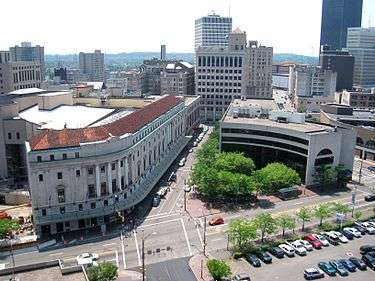
During World War II, Rochester was one of 131 colleges and universities nationally that took part in the V-12 Navy College Training Program which offered students a path to a Navy commission.[43] In 1942, the university was invited to join the American Association of Universities as an affiliate member and it was made a full member by 1944.[44] Between 1946 and 1947, in infamous uranium experiments researchers at the university injected uranium-234 and uranium-235 into six people to study how much uranium their kidneys could tolerate before becoming damaged.[45]
In 1955, the separate colleges for men and women were merged into The College on the River Campus. In 1958, three new schools were created in engineering, business administration, and education.[46] The Graduate School of Management was named after William E. Simon, former Secretary of the Treasury in 1986. He committed significant funds to the school because of his belief in the school's free market philosophy and grounding in economic analysis.[47]
Financial decline and name change controversy
Following the princely gifts given throughout his life, George Eastman left the entirety of his estate to the university after his death by suicide.[48] The total of these gifts surpassed $100 million, before inflation, and, as such, Rochester enjoyed a privileged position amongst the most well endowed universities. During the expansion years between 1936 and 1976,[49] the University of Rochester's financial position ranked third, near Harvard University's endowment and the University of Texas System's Permanent University Fund.[50] Due to a decline in the value of large investments and a lack of portfolio diversity, the university's place dropped to the top 25 by the end of the 1980s.[49] At the same time, the preeminence of the city of Rochester's major employers began to decline.
In response, the University commissioned a study to determine if the name of the institution should be changed to "Eastman University" or "Eastman Rochester University". The study concluded a name change could be beneficial because the use of a place name in the title led respondents to incorrectly believe it was a public university, and because the name "Rochester" connoted a "cold and distant outpost." Reports of the latter conclusion led to controversy and criticism in the Rochester community. Ultimately, the name "University of Rochester" was retained.[51][52][53][54]
Renaissance Plan
In 1995, university president Thomas H. Jackson announced the launch of a "Renaissance Plan" for The College that reduced enrollment from 4,500 to 3,600, creating a more selective admissions process.[55] The plan also revised the undergraduate curriculum significantly, creating the current system with only one required course and only a few distribution requirements, known as clusters.[56] Part of this plan called for the end of graduate doctoral studies in chemical engineering, comparative literature, linguistics, and mathematics,[55] the last of which was met by national outcry.[57] The plan was largely scrapped and mathematics exists as a graduate course of study to this day.[58]
Twenty-first century
Meliora Challenge
Shortly after taking office, university president Joel Seligman commenced the private phase of the Meliora Challenge, a $1.2 billion capital campaign, in 2005.[59] The campaign reached its goal in 2015, a year before the campaign was slated to conclude.[59] In 2016, the university announced the Meliora Challenge had exceeded its goal and surpassed $1.36 billion. These funds were allocated to support over 100 new endowed faculty positions and nearly 400 new scholarships.[60]
2017 US Equal Employment Opportunity Commission complaint
On September 1, 2017, a complaint was filed by eight current and former faculty members at the University of Rochester with the United States Equal Employment Opportunity Commission (EEOC). The complaint includes allegations of sexual misconduct/harassment perpetrated by a tenure track faculty member and condemnation of the response of University administration.[61] The university responded publicly that the allegations were thoroughly investigated and could not be substantiated.[62][63] The public disclosure of the EEOC filing dominated the discussion at a regularly scheduled Presidential Town Hall Meeting[64][65] and subsequent student protests included a campus rally and hunger strike.[66][67] In November 2017, hundreds of academics in the brain and cognitive science, neuroscience, and psychology fields at other colleges and universities signed an open letter discouraging their students from seeking admission or employment at the university.[68]
In response, the university's board of trustees announced an independent investigation into the allegations on September 19[69] and clarified the scope of the investigation and the composition of the committee on September 28, 2017.[70] The Board retained Mary Jo White, Senior Chair of Debevoise & Plimpton LLP and past United States Attorney for the Southern District of New York and Chair of the Securities and Exchange Commission, to lead the investigation slated to return their findings by the end of 2017. On January 11, 2018, the Debevoise & Plimpton released the report and held a press conference about the findings of the independent investigation.[71] The team found the individuals covered in the report had not violated policy; however, significant recommendations were made to push the university towards leadership in policy regarding relationships between faculty, staff, employees, and students.[72]
On the same day as the release of the report, university president Joel Seligman publicly announced his previously tendered resignation.[73] Board chair Danny Wegman accepted the resignation and tapped Richard Feldman, professor of philosophy, to serve as interim president.[74]
Administration
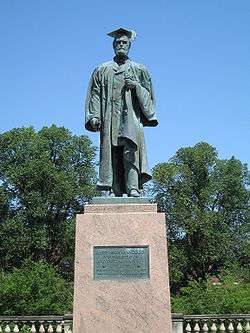
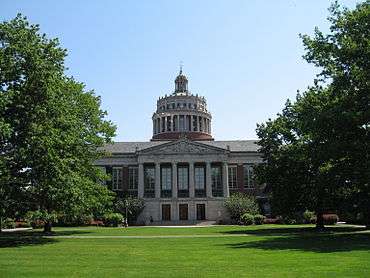
The university is headed by a board of trustees, with Danny Wegman being the chairman.[75] The board appoints the president of the university. Joel Seligman resigned as president in January 2018.[76] Shortly afterward, former Dean of the College, Richard Feldman, was named his successor for the interim period before a new president is selected.[2]
| Name | Tenure |
|---|---|
| Martin Brewer Anderson | 1853–1888 |
| David Jayne Hill | 1889–1896 |
| Benjamin Rush Rhees | 1900–1935 |
| Alan Valentine | 1935–1950 |
| Cornelis de Kiewiet | 1951–1961 |
| W. Allen Wallis | 1962–1975 |
| Robert Sproull | 1975–1984 |
| G. Dennis O'Brien | 1984–1994 |
| Thomas H. Jackson | 1994–2005 |
| Joel Seligman | 2005–2018 |
| Richard Feldman | 2018– (interim) |
Campuses
River Campus
The River Campus is in a bend of the Genesee River about 2 miles (3 km) south of downtown Rochester and covers around 200 acres (81 ha). It is bounded by Bausch & Lomb Riverside Park, an 18-acre (7.3 ha) public park along the east bank of the Genesee River formerly known as the Olmstead River Walk, and Mount Hope Cemetery, where the grave sites of Susan B. Anthony and Frederick Douglass can be found. The River Campus was acquired in the late 1920s from the Oak Hill Country Club through a land swap deal orchestrated in part by Edwin Sage Hubbell and funded largely by George Eastman.
After a period of landscaping, grading, and construction, the original buildings of the campus were dedicated in 1930 when the first class of River Campus Rats were welcomed to the Men's college. The main academic buildings are examples of the Greek Revival style in 20th century collegiate architecture. The four main buildings are situated upon the Eastman Quadrangle are Rush Rhees Library at the head, flanked by Morey Hall, Bausch & Lomb Hall, Lattimore Hall, and Dewey Hall. The Rush Rhees Library, the unofficial symbol of the university, is also home to the Hopeman Memorial Carillon, the largest carillon in New York State, featuring 50 bells that chime on the quarter-hour. During the summer, the carillon features a recital series in which various artists perform on the instrument.[78] Just off the quadrangle, in parallel, are Strong Auditorium and the Simon School of Business with the Interfaith Chapel opposite the Library. A Marc Mellon bronze of George Eastman was placed on the quadrangle in 2009.
Over the course of the last several decades, other academic buildings have been built south of the Eastman Quad, including Gavett Hall (dedicated with the Eastman Quad in 1930), Harkness Hall (1946), Hoyt Hall (1962), the Hopeman Engineering Building (1963), and Meliora Hall (1972). The southernmost part of the River Campus contains the new Science and Engineering Quadrangle: Wilmot Building (1961), Hylan Building (1971), Hutchison Hall (1972), the Computer Studies Building and Carlson Library (1987), the Robert B. Goergen Hall for Biomedical Engineering and Optics (2007), and Wegmans Hall housing the Goergen Institute for Data Science (2017). LeChase Hall (2013) and the Ronald Rettner Hall for Media Arts and Innovation (2013) were added to the north of the Eastman Quad on the Wilson Quadrangle behind Lattimore Hall and Morey Hall, respectively.[79]

Students often congregate outdoors during the warmer months on the various quads. Other centers of student life include Todd Union, Frederick Douglass Dining Center, various locations inside Rush Rhees Library, and Wilson Commons, a student union designed by the architectural firm of I.M. Pei. Many academic buildings, including Rush Rhees Library, are connected by a series of tunnels,[80] which are used extensively, especially during unfavorable weather. All academic buildings and common areas, as well as residence halls, have authenticated Wi-Fi internet access.[81]
River Campus is home to a number of student exhibition spaces. The AsIs Gallery in the Sage Art Center showcases rotating exhibitions of student works from studio classes in U of R. As a work-in-progress critique space, this exhibition space provides students the opportunity to develop their work in a semi-professional space. The Gallery at the Art and Music Library features work from students and local artists in the highly trafficked Rush Rhees Art and Music Library. Hartnett Gallery, in Wilson Commons, is a student supported gallery that showcases international and professional contemporary artists as well as an annual juried student exhibition. The pasSAGE is annex of Sage Art Center which features long term exhibition selected by a faculty committee. There is also a Senior Thesis Gallery in the Sage Arts Center that features senior undergraduate works.[82]
Medical Campus
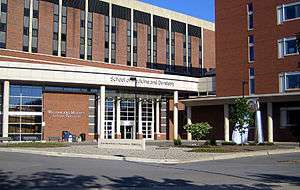
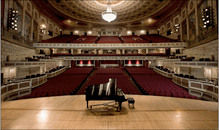
The University of Rochester Medical Center (URMC) is the primary campus for the university's medical education and research as well as the main patient care facility. The Medical Center is next to the River Campus and is dominated by Strong Memorial Hospital, the School of Medicine and Dentistry building and the Arthur Kornberg Medical Research Building. URMC also houses the School of Nursing and a variety of research centers, including the Wilmot Cancer Center, the Aab Institute of Biomedical Sciences, and the Clinical and Translational Sciences Institute.
The Eastman School of Music
The Eastman School of Music is situated on its own campus in downtown Rochester, which includes a residence for students, classroom and performance facilities, and the Eastman Theatre, a 2,326-seat concert hall which also serves as the primary venue of the Rochester Philharmonic Orchestra. The campus also features the Sibley Music Library, which is the largest academic music library in North America, as well as the largest privately owned collection of sheet music. Students are housed at 100 Gibbs Street, a dormitory building constructed in 1991.
South Campus
The South Campus is in Brighton, immediately south of Rochester proper. The campus includes the Laboratory for Laser Energetics, a Department of Energy-funded national lab, the Center for Optics Manufacturing, the Center for Optoelectronics and Imaging, and the now defunct Nuclear Structure Research Laboratory (NSRL). Graduate student housing is also provided at the Whipple Park complex.
Mount Hope Campus
The Mount Hope Campus consists of a number of old mansion homes including the Witmer Family House,[83] which serves as the official residence of the President of the University, and the Patrick Barry House,[84] which serves as the official residence of the Provost of the University.
Bristol Mountain Observatory
An observatory owned and operated by the university is named in honor of the scientist Dr. C. E. Kenneth Mees, university professor and Eastman Kodak scientist.
Prince Street Campus and Memorial Art Gallery
The university's first permanent campus was at the former farm of Azariah Boody.[85] While a number of buildings still stand including Anderson Hall, the Eastman Laboratories, and a number of student dormitories, these buildings have been absorbed by private companies or the Rochester School of the Arts. The university retains control of a few acres of land including the land under the Sibley Library (razed), old campus gates, the Memorial Art Gallery old and new wings, and the Culter Union, a prime example of the Collegiate Gothic style of 20th century architecture.
The Memorial Art Gallery was founded in 1913 as a part of the University of Rochester through a gift from Emily Sibley Watson as a memorial to her son, James George Averell.[86] It was designed by the prominent American architectural firm McKim, Mead, and White and occupies the southern half of the university's Prince Street campus.[87] It is the focal point of fine arts activity in the region and hosts the biennial Rochester-Finger Lakes Exhibition and the annual Clothesline Festival.
Academics
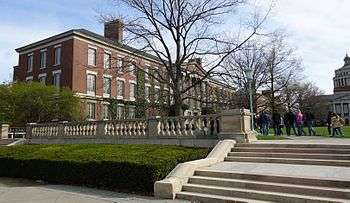
The University of Rochester's undergraduate enrollment includes approximately 5,800 full-time and about 200 part-time students from across the U.S. and over 115 countries.[88] Graduate enrollment includes approximately 3,900 full-time and about 1,100 part-time graduate students. The university has more than 103,000 living alumni and employs nearly 2,300 tenure-track faculty, with more than 20,000 faculty and staff across the university and the Strong Health System.[89]
The only required undergraduate course is the first year writing seminar. In lieu of a core curriculum, undergraduates complete coursework in each of three disciplines: humanities, social sciences, and natural sciences. Students choose a major, consisting of more than ten courses, and a cluster, consisting of three related courses. The student must ensure at least a cluster is met in each discipline; however, second majors and minors are often used to fulfill these requirements. Students who pursue accredited engineering fields including biomedical engineering, chemical engineering, electrical and computer engineering or mechanical engineering, are exempt from this system and are only required to have one humanities or social science cluster.
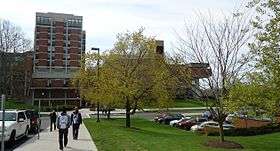
Rochester offers juniors and seniors the opportunity to apply for full funding for a fifth year of study. These programs include Take Five Scholars program and the Kauffman Entrepreneurial Year (KEY) Scholarship. "Take-Five" and "Key", as they are colloquially known, allow for study in a field unrelated to an undergraduate major or the pursuit of an innovative entrepreneurial project with an impact on the local area, respectively.[90][91]
The University further offers a number of combined undergraduate - graduate tracks. These include Rochester Early Medical Scholars (REMS), Rochester Early Business Scholar (REBS), Graduate Engineering At Rochester (GEAR), and Guaranteed Rochester Accelerated Degree in Education (GRADE) programs. These programs are open to prospective students, who must apply for these prior to entering the university.[92]
Rankings
| University rankings | |
|---|---|
| National | |
| ARWU[93] | 52-65 |
| Forbes[94] | 83 |
| U.S. News & World Report[95] | 33 |
| Washington Monthly[96] | 53 |
| Global | |
| ARWU[97] | 101-150 |
| QS[98] | 190 |
| Times[99] | 158 |
| U.S. News & World Report[100] | 111 |
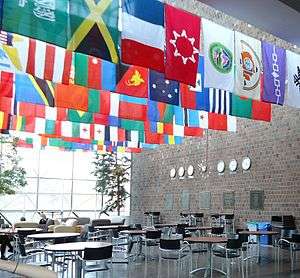
UR was one of the 25 New Ivies in the 2007 Kaplan/Newsweek "How to Get into College Guide."[101] The list names institutions whose caliber of students is considered to rival traditional Ivy League schools.[101] The rankings are based on admissions statistics as well as interviews with administrators, students, faculty, and alumni.[102]
The fall 2018 acceptance rate was 29.6%.[103] UR is ranked 34th among national universities and 111th among global universities by U.S. News & World Report, and 144th by Washington Monthly. The school places within the Top 10 for the staff-to-student ratio.[104]
The doctoral programs for economics and political science are historically ranked among the top five worldwide in career placement and alumni success, despite their small size.[26][27] According to a paper in the Annual Review of Political Science, the University of Rochester launched the positive political theory revolution and established rational choice theory as mainstream within the field of political science.[105] A 2001 study in PS – Political Science & Politics ranked Rochester first in the country in PhD alumni productivity, measured by publications in leading journals adjusted for department size.[106] In 2007, two PS: Political Science & Politics studies ranked Rochester fourth in both graduate placement and citations of graduates' research.[107][108] Only Harvard University and the University of Rochester placed in the top five in both graduate placement and publications.
The Eastman School of Music ranks first among music schools in the U.S.[10][11] U.S. News & World Report also ranked the Hajim School of Engineering's graduate program 38th nationally; additionally, the graduate programs of political science, international relations, economics, and medical research were ranked 15th, 14th, 22nd, and 31st in the nation, respectively.[109]
Rochester is a member of the Association of American Universities and enjoys the highest ranking from the Carnegie Classification of Institutions of Higher Education for "highest research activity."[110]
Rush Rhees Library at The University of Rochester was featured on the cover of the "Princeton Review 373 Best Colleges 2011 Edition".

The High Impact Universities Initiative which measures research performance ranked the University of Rochester 28th in the world.[111]
Research
The university consistently ranks among the top 40 colleges and universities nationwide in federally financed science, engineering, medical, and other research, with a research budget of around $395 million[112] spread across many departments and research centers,[113] including the Laboratory for Laser Energetics, a laser-based nuclear fusion facility, and the extensive research facilities at the University of Rochester Medical Center. Recently, the university has also engaged in a series of new initiatives to expand its programs in biomedical engineering and optics, including the construction of the new $37 million Robert B. Goergen Hall for Biomedical Engineering and Optics on the River Campus.[114] Other new research initiatives include a cancer stem cell program and a Clinical and Translational Sciences Institute.[115][116] UR also has the ninth highest technology revenue among U.S. higher education institutions, with $46 million being paid for commercial rights to university technology and research in 2009.[117] Notable patents include Zoloft and Gardasil. WeBWorK, a web-based system for checking homework and providing immediate feedback for students, was developed by University of Rochester professors Gage and Pizer. The system is now in use at over 800 universities and colleges, as well as several secondary and primary schools.[118] Rochester scientists work in diverse areas; for example, physicists developed a technique for etching metal surfaces, such as platinum, titanium and brass, with powerful lasers, enabling self-cleaning surfaces that repel water droplets and will not rust if tilted at a 4 degree angle;[119] and medical researchers are exploring how brains rid themselves of toxic waste during sleep.[120]
Colleges and schools
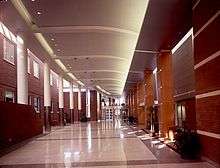
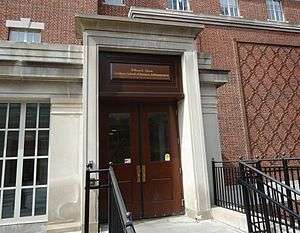
- College of Arts, Sciences, and Engineering - Undergraduate and graduate programs in a large number of fields. This is the largest college of the university by both undergraduate and graduate enrollment. The College is divided into two schools: The School of Arts and Sciences and the Hajim School of Engineering and Applied Sciences. The College is primarily on the River Campus.
- The Eastman School of Music is a music conservatory offering both undergraduate and graduate education in a number of music fields, including composition, theory, and performance.
- The Margaret Warner Graduate School of Education and Human Development is the university's graduate school of education. It is on the River Campus in LeChase Hall.
- The School of Medicine and Dentistry is a medical and dental school with both research and clinical programs. It is in the University of Rochester Medical Center.
- The School of Nursing is a nursing school. It is also on the campus of the University of Rochester Medical Center.
- Simon Business School is the business school. It is on the River Campus.
Student life
UR's official symbol is the seal of the university, which features a book, representing arts and sciences, a lyre symbolizing music, and a modified symbol of medicine.[121] The official flower of the university is the dandelion, purportedly prolific on the cow pasture that became the university's second campus.[122]
The official mascot of the university is a predatory wasp found throughout Rochester, the Yellowjacket. From 1983 to 2008, the yellowjacket mascot was named "URBee." However, when the university re-designed the mascot during the 2007-2008 academic year, a new name was chosen and as of February 1, 2008, the school's mascot is now known as "Rocky".[123][124]
The university uses Dandelion Yellow and Rochester Blue as its official colors, which are the prominent colors on the official regalia.[125]
The motto of UR is Meliora, which loosely translates to "better" with the connotation of "ever better," the meaning adopted by the university.[126]
The image of Rush Rhees Library's main dome serves as an additional icon for the University of Rochester.
The song most often sung at college events, led often by the school's many a cappella groups, is The Genesee,[127] written by former Rochester student Thomas Thackeray Swinburne (Class of 1892).[128] Although less frequently used, the university also has an official Alma Mater, The Dandelion Yellow.[129]
Student organizations
The student body at the University of Rochester is both ethnically and socioeconomically diverse. There are over 200 active Students' Association recognized groups on campus, which range from cultural dance groups to U of R's comedy improv troupe In Between the Lines.[130] Since 1873, the University has regularly printed its student newspaper, the Campus Times.[131] There is also the student-run, online-only publication, The Rival Rochester. This is a source of opinion, commentary, and satire. Several a cappella groups play a prominent role in campus life. The YellowJackets[132] competed on Season 3 of NBC's "The Sing-Off" during the fall 2011 season, finishing 7th nationwide.[133] The Midnight Ramblers are the centerpiece of the university's admissions video, Remember oUR Name on YouTube.[134] The University of Rochester is also home to its own radio station, WRUR.
Residences
The majority of undergraduate students at the university live and take classes on the River Campus. Underclassmen are generally required to live on campus while upperclassmen have the option to live off campus. Some graduate housing is provided by the university, but a significant number also live off campus. Housing is provided at multiple locations spread across the several campuses.[135]
River Campus River Campus residences house primarily undergraduates, with some graduate students serving as Graduate Head Residents (GHRs). Residences include:
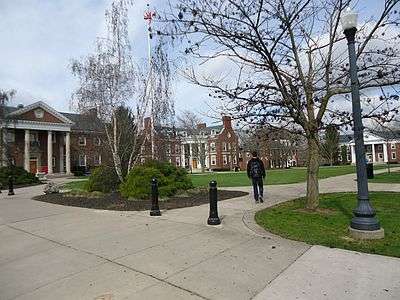
- Fraternity Quadrangle consists of nine houses, including seven fraternities (Alpha Delta Phi, Delta Kappa Epsilon, Psi Upsilon, Sigma Alpha Mu, Sigma Chi, Sigma Phi Epsilon, and Theta Chi); in addition, two special interest housing groups—the Douglass Leadership House and the Drama House—maintain housing here.
- Freshman Housing - Consists of Susan B. Anthony Halls (Gannett, Gates, Hollister, and Morgan), near Rush Rhees Library, Hoeing Hall, Tiernan Hall, Gilbert Hall, and Lovejoy Hall which are on the Residence Quad. Freshmen live together in these specially designated residences that feature increased supervision, regulation, and residence-related activities by upperclassmen Dandelions (affectionately known as D'Lions) and Freshman Fellows, along with Residential Advisers in living areas.
- Hill Court - Upperclass housing consisting of Chambers, Fairchild, Gale, Kendrick, Munro, and Slater houses, which are connected by underground tunnels. This residence area, opened in 1969, is colloquially known as "Phase" and was the newest residential area on the River Campus prior to the construction of the Riverview Complex.
- Residence Quad (ResQuad) - Consists of Burton, Lovejoy and Crosby Halls for upperclassmen, as well as Hoeing, Gilbert, Tiernan and Lovejoy Halls for freshmen. Burton and Crosby were the original dormitories on the River Campus, constructed in 1930, while the other four were built during the 1950s. All ResQuad buildings were fully renovated in the 1990s. (Lovejoy Hall is mostly upperclassmen but has included a freshman floor due to an increase in enrollment.)
- River Campus Towers - Consists of O'Brien Hall, and Anderson and Wilder Towers. It houses upperclassmen and several Special Interest Housing groups. The formal name for the area is Jackson Court (formerly known as "Founders Court"), but it is simply called "Towers" by most students. Built in 1962, they are scheduled to undergo extensive renovations in the near future. O'Brien Hall opened up to students in 2012.
- Southside - Southside consists of Valentine and deKiewiet Towers, as well as several single-story house-style "maisonettes", which offer apartment style living to upperclassmen. The residences are south of the River Campus near the medical center, but house River Campus undergraduate students. The campus master plan shows that this complex will eventually be razed.[citation needed]
- Riverview - The only housing complex on the western side of the Genesee River, Riverview opened for the 2008-2009 school year, making it the first addition to the campus's housing in nearly 40 years. The complex consists of five buildings, which can house up to 400 undergraduates. The complex is made up of fully furnished two-to-four person apartments.
Special Interest floors and Fraternity floors also exist within the residence halls. Special Interest Housing groups include Tiernan Project (Burton 2), Delta Upsilon (Wilder 3), Sigma Delta Tau (Wilder 4), Chi Omega (Wilder 5), Kappa Delta (Wilder 6), Inter-Class Living Community (ICLC - Crosby 1), Music Interest Floor (MIF - Wilder 9), Computer Interest Floor (CIF - Anderson 3), Anime Interest Floor (AIF - Anderson 7), Alpha Phi (Munro 2), and Greenspace (Burton 1).
Eastman School of Music Campus Housing is provided at the Eastman School of Music campus at the Eastman Student Living Center at 100 Gibbs Street in downtown Rochester. The new building was opened in 1991 at the northeast corner of Main and Gibbs Streets, replacing the University Avenue dormitories built nearly 70 years earlier. It is a four-story quadrangle and 16-story tower surrounding a landscaped inner courtyard.
URMC and Mount Hope Campuses Graduate student housing is provided at several locations near the URMC. It should be noted that these facilities also house select River Campus, non-traditional students who have been deemed too old for traditional housing.
- George Washington Goler House (GHS) immediately adjacent to the grounds of the URMC. It is a high rise apartment building with 321 apartments. The building also houses university community members, including faculty and staff.
- University Park (UPK) is a complex of two story buildings that include 40 studio, 86 one-bedroom, and 80 two-bedroom unfurnished apartments. UPK is near the URMC, directly across from Southside off of Kendrick Road. Graduate students and their families are the primary occupants of these apartments, but some non-traditional undergraduate students are housed here who have been deemed too old for traditional undergraduate housing on the River Campus. Students who live here typically take up residence year round.
South Campus The South Campus has graduate student housing at the Whipple Park (WPK) complex, which features 250 garden apartments and townhouses with ample storage space. WPK also features a park-like setting with large wooded and lawn areas, playgrounds, areas for gardens and low street noise. Some housing is also provided at the River Road complex, which tends to serve as overflow housing for both undergraduate and graduate students.
Students' Association
The Students' Association (SA) is the primary student governing body and includes most of the student groups at UR. It is governed by the SA Senate, President and Vice President, all of whom are elected by the student body. The SA President may choose to appoint an advisory cabinet made up of a group of volunteer students. There is also a judicial branch, composed of the All Campus Judicial Council (ACJC), the members of whom are nominated by an interview committee and approved by the SA Senate. The SA Senate meets weekly and the longest meeting on record lasted longer than 8 hours. The offices of the SA are in the Wilson Commons student union.[136]
All student groups are required to have a constitution, elected officers, and approval from senate in order to be recognized by the SA and have access to university funds. These funds are given yearly based on budgets submitted to the Students' Association Appropriation Committee (SAAC)[137] with supplemental funds available through special forms. All funds are derived from the mandatory Student Activities Fee.
Athletics
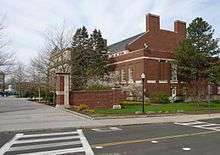
UR's athletics teams are called the Yellowjackets. They participate in the Division III of the NCAA and in the University Athletic Association and Liberty League. One exception to this is the men's squash team, which is consistently ranked top 5 in Division I.[138] The University fields men's teams in baseball, basketball, cross country, football, golf, rowing, soccer, swimming and diving, tennis, and track and field. On the women's side, UR sponsors teams in basketball, cross country, field hockey, lacrosse, soccer, rowing, softball, swimming and diving, tennis, track and field, and volleyball. Popular club sports include ultimate frisbee, rugby, and soccer, which all have men's and women's teams. The Men's Rugby team has enjoyed recent success, with a New York State Conference Championship in 2011. The team was ranked 9th in the nation out of 151 Division III teams for the 2011-2012 season.[139] In 2009 women's soccer coach Terry Gurnett set records with over 400 lifetime wins.[140][141] In March 2010 the women's basketball team made it to the NCAA's Final Four.
There are also numerous club and intramural athletics groups.
The main athletics facilities of the university are in the Robert B. Goergen Athletic Center and Fauver Stadium on the River Campus, with other facilities in the Spurrier building (River Campus) and the URMC.[142][143]
Campus and area transportation
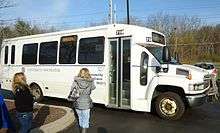
The UR campuses have their own University-sponsored system of buses, or shuttles, which provide free transportation from the River Campus to the Medical Center, South Campus, Eastman Campus, and Riverview. There are also lines that run between the River Campus and local shopping and entertainment in Henrietta and Pittsford. On the weekends, a shuttle loops to the Rochester Public Market. Most of the University-sponsored buses are named using a color system (i.e. Red Line) that indicates their respective route and allows for easy identification. Several bus lines of the Rochester-Genesee Regional Transportation Authority (RTS) also make stops at the University.
The university participates in the Zipcar program, which allows students to rent cars on an hourly or daily basis.[144][145]
The Greater Rochester International Airport is a ten-minute drive to the west of the River Campus. In addition, Amtrak train and Greyhound bus have stations in downtown Rochester to the north of the campus.
Traditions
Rochester observes several traditional events throughout the year with diverse history.[146][147][148][149]
Formal academic events
Convocation celebrates the start of the academic year and provides the opportunity for students, faculty, and staff to come together. The ceremony opens with a processional by faculty and administrators in traditional regalia, features presentation of the Goergen Awards for contributions to undergraduate education, and is accompanied by a picnic, activities fair and performances.
Commencement is the formal end of the academic year. The university community gathers for a large ceremony of the Eastman Quadrangle. Members of the Board of Trustees, the President of the University, the President of the Senior Class, and a speaker selected by the administration offer remarks and advice. Degrees are then conferred at separate ceremonies by school and department.
University community weekends
Yellowjacket Weekend directly follows Freshman Orientation. With the entire student body reunited, this weekend serves as the first official welcome to the Fall semester.[150]
Meliora Weekend combines homecoming, class reunions, and family weekend. Events run from Thursday through Sunday and unite all campuses through common programming and events. The keynote is given each Saturday morning in Kodak Hall at the Eastman School. Past keynote speakers include Amartya Sen, Anderson Cooper, Stephen Colbert, Colin Powell, Sanjay Gupta, Bob Gates, Dorris Kearns Goodwin, former President of the United States Bill Clinton, and former United States Secretary of Energy and University of Rochester alumnus Steven Chu.
Winterfest Weekend is the kickoff to the second semester and allows students to bask in the snowy Rochester winters. Highlights of the weekend include comedic performances (previous comedians include Demetri Martin, B.J. Novak and Michael Ian Black), sleigh rides and ice skating.
Dandelion Day, colloquially known as D-Day, was a Saturday late in the spring semester established as an annual respite around final exams with extensive celebrations, recently accompanied by a carnival and musical guests. Previous years have featured Super Mash Bros., Reel Big Fish, Eve 6, Talib Kweli, and Big Bad Voodoo Daddy. OK Go performed in 2010. In 2012, D-Day was moved from Saturday to Friday and has since been rebranded as the start of Springfest Weekend in an effort by the administration to refocus the focus from revelry and debauchery.[151]
Boar's Head Feast
in 1934, the men of the River Campus held the first Boar's Head Dinner. While the women of Prince Street moved to the River Campus in 1955, the event remained single gender until 1971 when women joined the men in 17th century garb.[152] This yearly feast was begun at Queen's College Oxford; the University of Rochester's variation on this theme includes performances by university a cappella, circus arts, and performance groups. The student body selects one faculty member each year to tell the story of the student and the boar. While each raconteur takes their own poetic liberties, the arc is the same: the wayward student in the forest defeats the boar with their calculus textbook.
Wilson Day
Wilson Day, named for university benefactor Joseph C Wilson, is day of community service for all incoming university students which include working on neighborhood picnics, voter registrations, painting, landscaping, meal service, and various other service efforts in the community.
Notable alumni and faculty
List of Nobel Laureates affiliated with the University of Rochester
The University of Rochester has more than 103,000 alumni as of 2011.[153] Rochester counts among its alumni former Presidents of The University of Chicago, Massachusetts Institute of Technology, Tufts University, and the University of California, San Francisco (Chancellor), and Deans of the Harvard Medical School, Stanford University School of Medicine, UCSF School of Medicine, The University of Chicago Irving B. Harris School of Public Policy Studies, and other graduate and professional schools. In total, Deans of four of the U.S. News & World Report top 10 medical schools were educated at Rochester.[154] 10 percent of undergraduates later earn a PhD.[155] Nearly a quarter of the scientists on NASA’s advisory board for the James Webb Space Telescope (scheduled to launch in May 2020) are alumni or faculty members.[156]
 Richard Thaler (MA 1970; PhD 1976; Assistant Professor, Simon Business School), Father of behavioral economics, recipient of the 2017 Nobel Memorial Prize in Economic Sciences "for his contributions to behavioural economics," Charles R. Walgreen Distinguished Service Professor of Behavioral Science and Economics, Director of the Center for Decision Research, The University of Chicago Booth School of Business
Richard Thaler (MA 1970; PhD 1976; Assistant Professor, Simon Business School), Father of behavioral economics, recipient of the 2017 Nobel Memorial Prize in Economic Sciences "for his contributions to behavioural economics," Charles R. Walgreen Distinguished Service Professor of Behavioral Science and Economics, Director of the Center for Decision Research, The University of Chicago Booth School of Business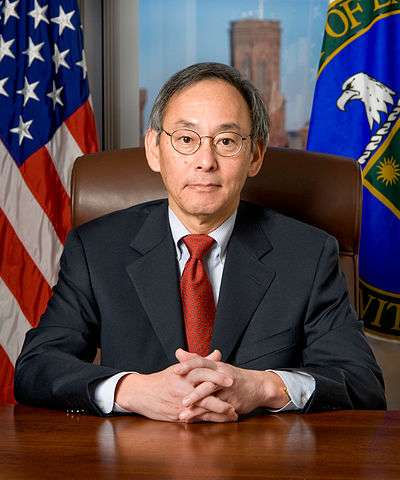 Steven Chu (B.A., B.S. 1970), recipient of the 1997 Nobel Prize in Physics "for development of methods to cool and trap atoms with laser light" and 12th United States Secretary of Energy
Steven Chu (B.A., B.S. 1970), recipient of the 1997 Nobel Prize in Physics "for development of methods to cool and trap atoms with laser light" and 12th United States Secretary of Energy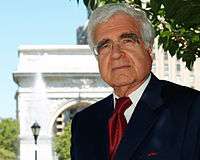 Arthur R. Miller (A.B. 1955), legal scholar, formerly Bruce Bromley Professor of Law at Harvard Law School and University Professor at NYU since 2007
Arthur R. Miller (A.B. 1955), legal scholar, formerly Bruce Bromley Professor of Law at Harvard Law School and University Professor at NYU since 2007 Joseph B. Martin (Ph.D. 1971), Former Dean of Harvard Medical School and the UCSF School of Medicine, 6th Chancellor of the University of California, San Francisco, Edward R. and Anne G. Lefler Professor Emeritus of Neurobiology at Harvard Medical School
Joseph B. Martin (Ph.D. 1971), Former Dean of Harvard Medical School and the UCSF School of Medicine, 6th Chancellor of the University of California, San Francisco, Edward R. and Anne G. Lefler Professor Emeritus of Neurobiology at Harvard Medical School.jpg) Paul Singer (businessman) (B.S. 1966), Billionaire, founder and CEO of hedge fund Elliott Management Corporation, the largest activist fund in the world
Paul Singer (businessman) (B.S. 1966), Billionaire, founder and CEO of hedge fund Elliott Management Corporation, the largest activist fund in the world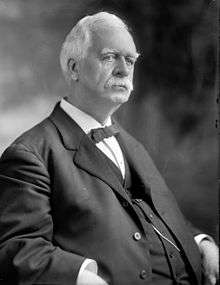
 Susan Hockfield (B.A. 1973), Neuroscientist, Former Dean of the Yale Graduate School of Arts and Sciences, Provost of Yale University, 16th President of the Massachusetts Institute of Technology
Susan Hockfield (B.A. 1973), Neuroscientist, Former Dean of the Yale Graduate School of Arts and Sciences, Provost of Yale University, 16th President of the Massachusetts Institute of Technology
Gallery
 Flagpole on the River Campus bearing the seal of the university.
Flagpole on the River Campus bearing the seal of the university.- Eastman Quad from the balcony of Rush Rhees Library.
 Meliora statues.
Meliora statues.- Wilson Commons student union. Designed by the architectural firm of I.M. Pei.
 The old student union, Todd Union (now home to the Music and Theater departments), with its replacement, Wilson Commons, in the background.
The old student union, Todd Union (now home to the Music and Theater departments), with its replacement, Wilson Commons, in the background. Inside Wilson Commons at an indoor "outdoor" cafeteria lounge.
Inside Wilson Commons at an indoor "outdoor" cafeteria lounge. According to one tradition, if an undergraduate steps on the yellow seal at the base of this clock tower, he or she will not graduate in four years, but in five or more. Wilson Commons is to the left.
According to one tradition, if an undergraduate steps on the yellow seal at the base of this clock tower, he or she will not graduate in four years, but in five or more. Wilson Commons is to the left. Main academic quadrangle.
Main academic quadrangle. Walkway between Strong auditorium (left) and Lattimore Hall (right). The Margaret Warner Center building (LeChase Hall) is shown under construction (center-right).
Walkway between Strong auditorium (left) and Lattimore Hall (right). The Margaret Warner Center building (LeChase Hall) is shown under construction (center-right). The Susan B. Anthony residence hall has four wings and a dining center.
The Susan B. Anthony residence hall has four wings and a dining center.- Wilson Quad during a snowstorm
 View of Crosby and Burton halls from Wilson Commons.
View of Crosby and Burton halls from Wilson Commons. Inside the atrium at Wilson Commons.
Inside the atrium at Wilson Commons.
See also

- George Eastman House
- University of Rochester Arboretum
References
- ↑ http://www.rochester.edu/endowment/performance-reports/
- 1 2 "Richard Feldman appointed interim president". NewsCenter. University of Rochester. 12 January 2018. Retrieved 20 February 2018.
- ↑ University of Rochester Identity Guide (PDF). Retrieved June 25, 2017.
- ↑ NAICU – Member Directory Archived 2015-11-09 at the Wayback Machine.
- ↑ rochester.edu
- ↑ "Points of Pride". www.rochester.edu. Retrieved 2017-12-30.
- ↑ State.NY.us Archived 2015-12-10 at the Wayback Machine., New York State Department of Labor: Workforce Industry Data
- ↑ "NSF Rankings by total R&D expenditures". National Science Foundation.
- 1 2 "uscollegeranking.org". Archived from the original on 2016-05-21. Retrieved 2016-02-03.
- 1 2 3 http://sybariticsinger.com/2013/04/02/musicschools2012/
- 1 2 3 http://vinceleemusic.blogspot.com/2012/03/music-school-rankings-hysteria.html
- ↑ "Check out the Top 15 Music Colleges In the US - Music School Central". Music School Central. 2014-09-30. Retrieved 2017-12-30.
- ↑ "Sibley Music Library - Eastman School of Music". www.esm.rochester.edu. Retrieved 2017-12-30.
- ↑ http://im.ft-static.com/content/images/16ed3bda-e491-11e6-9645-c9357a75844a.pdf
- ↑ https://www.scimagojr.com/journalrank.php?category=2003
- ↑ "University of Rochester Medical School". Archived from the original on 2017-05-24.
- ↑ "U.S. Patent Awarded for Rochester's Pioneering HPV Vaccine Work". www.urmc.rochester.edu. Retrieved 2018-06-11.
- ↑ Small molecule efflux pump inhibitors, 2015-06-12, retrieved 2018-06-11
- ↑ "Donald A. Henderson, M.D. - Class of '54 - Alumni Class Reflections - Alumni - School of Medicine and Dentistry - University of Rochester Medical Center - University of Rochester Medical Center". www.urmc.rochester.edu. Retrieved 2018-06-11.
- ↑ Engel, G. L. (1981-01-01). "The Clinical Application of the Biopsychosocial Model". Journal of Medicine and Philosophy. 6 (2): 101–124. doi:10.1093/jmp/6.2.101. ISSN 0360-5310.
- ↑ "Rare Books & Manuscripts, Miner Library". www.urmc.rochester.edu. Retrieved 2018-06-11.
- ↑ http://www.hajim.rochester.edu/optics/about/index.html
- ↑ https://www.osapublishing.org/viewmedia.cfm?r=1&rwjcode=ao&uri=ao-9-4-789&html=true
- ↑ http://www.rochester.edu/college/psc/people/phd-alumni/ Political Science Alumni
- ↑ http://www.econ.rochester.edu/graduate/placement.html Economics Alumni
- 1 2 http://www.people.fas.harvard.edu/~gillum/rankings_paper.pdf Political Science
- 1 2 http://pubs.aeaweb.org/doi/pdfplus/10.1257/jep.28.3.205 Economics (table 2)
- ↑ "Synthesis of Morphine by Marshall D. Gates (1952)". www.synarchive.com. Retrieved 2017-12-30.
- ↑ "Rossell Hope Robbins Library | River Campus Libraries". www.library.rochester.edu. Retrieved 2017-12-30.
- ↑ , World’s Most Powerful Laser has the Energy of a Hydrogen Bomb
- ↑ "History". First Baptist Church. Retrieved 2017-12-04.
- ↑ "University of Rochester History: Chapter 2, Hamilton vs. Rochester | RBSCP". rbscp.lib.rochester.edu. Retrieved 2017-12-04.
- ↑ "Origins of Colgate University". Colgate University. Retrieved 4 October 2018.
- ↑ "Origins of Colgate University". Colgate University. Retrieved 4 October 2018.
- ↑ "Origins of Colgate University". Colgate University. Retrieved 4 October 2018.
- 1 2 3 "University of Rochester History: Chapter 3, The Year of Decisions: 1850 | RBSCP". rbscp.lib.rochester.edu. Retrieved 2017-12-05.
- ↑ Gonnaud, Maurice (2014-07-14). An Uneasy Solitude: Individual and Society in the Work of Ralph Waldo Emerson. Princeton University Press. ISBN 9781400858903.
- ↑ "University of Rochester History: Chapter 6: A Critical Decade | RBSCP". rbscp.lib.rochester.edu. Retrieved 2017-12-05.
- ↑ May, Arthur J. (1977) A History of the university of Rochester, Princeton: Princeton University
- ↑ "University of Rochester Library Bulletin: George Eastman and the University of Rochester, His Role, His Influence | RBSCP". rbscp.lib.rochester.edu. Retrieved 2017-12-05.
- ↑ "History - School of Medicine and Dentistry - University of Rochester Medical Center - University of Rochester Medical Center". www.urmc.rochester.edu. Retrieved 2017-12-05.
- ↑ "History of Eastman Dental - Eastman Institute of Oral Health - University of Rochester Medical Center". www.urmc.rochester.edu. Retrieved 2017-12-05.
- ↑ "The News about the University of Rochester, 1944". GenWeb Monroe County. 2010. Retrieved September 25, 2011.
- ↑ "University of Rochester History: Chapter 29, The Impact of Pearl Harbor | RBSCP". rbscp.lib.rochester.edu. Retrieved 2017-12-05.
- ↑ Goliszek, 2003: pp. 136–137
- ↑ University of Rochester: Archived 2016-03-03 at the Wayback Machine. History and Distinctions
- ↑ Schmitt, Eric (1986-10-29). "A SCHOOL TO SIMON'S LIKING". The New York Times. ISSN 0362-4331. Retrieved 2017-12-05.
- ↑ "Eastman dies by own hand" (PDF).
- 1 2 Jarrell, Gregg (1993). "University of Rochester's Endowment Fund Review".
- ↑ https://www.aeaweb.org/articles?id=10.1257/jep.22.3.207
- ↑ , University of Rochester Urged to Change Name
- ↑ What's in a Name? Plenty, Argue University's Alumni
- ↑ Our Towns--Change of Image in "Cold and Distant Outpost
- ↑ Pieterse, "Our Work Is But Begun: A History of the University of Rochester 1850-2005" (Boydell & Brewer, 2014), pg. 165
- 1 2 "Appendix 2: Letter to Rochester Faculty from President Jackson, Provost Phelps, and Dean Aslin". Archived from the original on 2018-06-16.
- ↑ Rochester.edu, Press Release: Rochester Renaissance Plan for The College
- ↑ "Downsizing at Rochester: Mathematics Ph.D. Program Cut" (PDF).
- ↑ Arenson, Karen W. (1996-02-04). "Fears That Loss of a Math Ph.D. Program Figures in a Bigger Equation". The New York Times. ISSN 0362-4331. Retrieved 2017-12-18.
- 1 2 "UR's campaign reaches $1.2 billion goal". Rochester Democrat and Chronicle. Retrieved 2018-06-16.
- ↑ "Meliora Challenge campaign exceeds expectations with historic $1.37 billion". NewsCenter. 2016-07-07. Retrieved 2017-12-05.
- ↑ "UR EEOC Full Text".
- ↑ "University of Rochester responds to sexual harassment complaint against professor". Rochester Democrat and Chronicle. Retrieved 2017-09-10.
- ↑ "UR complainants vs. Seligman: War of words heats up over prof accused of sexual harassment". Rochester Democrat and Chronicle. Retrieved 2017-09-12.
- ↑ "Seligman faces hundreds as campus outrage peaks". The Campus Times. Retrieved 2017-09-13.
- ↑ "UR President Joel Seligman apologizes for comment in sexual harassment case". Rochester Democrat and Chronicle. Retrieved 2017-09-13.
- ↑ "UR student criticism of handling sexual harassment allegations mounts". Rochester Democrat and Chronicle. Retrieved 2017-09-14.
- ↑ "After nearly six days, Wrobel off hunger strike". The Campus Times. Retrieved 2017-09-19.
- ↑ "Professors say they won't advise students to work or study at U of Rochester". Retrieved 2017-11-16.
- ↑ Message from the University of Rochester Board of Trustees. "Rochester launches new inquiry into harassment accusations". University of Rochester Newsroom.
- ↑ "Message from the Special Committee of the University of Rochester Board of Trustees". NewsCenter. 2017-09-28. Retrieved 2017-11-22.
- ↑ "University of Rochester Independent Investigation". urindependentinvestigation.net. Retrieved 2018-02-24.
- ↑ Wang, Vivian (2018). "Exonerated, University of Rochester President Steps Down". The New York Times. ISSN 0362-4331. Retrieved 2018-02-24.
- ↑ "Office of the President :: University of Rochester". www.rochester.edu. Retrieved 2018-02-24.
- ↑ "Richard Feldman appointed interim president". NewsCenter. 2018-01-12. Retrieved 2018-02-24.
- ↑ University of Rochester News Release: Danny Wegman becomes board chair, two new trustees named
- ↑ Wang, Vivian (11 January 2018). "Exonerated, University of Rochester President Steps Down". The New York Times. Retrieved 20 February 2018.
- ↑ University of Rochester: Archived 2009-11-03 at the Wayback Machine. Presidents of the University
- ↑ "Hopeman Memorial Carillon: Frequently Asked Questions
- ↑ Interactive Map of the River Campus Archived 2009-09-16 at the Wayback Machine.
- ↑ Rochester.edu Archived 2009-02-05 at the Wayback Machine., tunnels
- ↑ UR Wireless Coverage Archived 2015-10-16 at the Wayback Machine.
- ↑ Campus Galleries : Art & Art History : University of Rochester Archived 2014-03-14 at the Wayback Machine.. Rochester.edu (2012-01-12). Retrieved on 2014-03-25.
- ↑ "Rochester Review • University of Rochester". www.rochester.edu. Retrieved 2018-05-01.
- ↑ "Patrick Barry House". www.rochester.edu. Retrieved 2018-05-01.
- ↑ "Rochester Review :: University of Rochester". www.rochester.edu. Retrieved 2018-05-01.
- ↑ Elizabeth., Brayer, (1988). Magnum opus : the story of the Memorial Art Gallery, 1913-1988 (1st ed.). Rochester, N.Y.: The Gallery. ISBN 9780918098023. OCLC 18496839.
- ↑ Klauder, Charles Zeller; Wise, Herbert Clifton (1929). College architecture in America and its part in the development of the campus. New York : London: C. Scribner's Sons.
- ↑ Diversity at Rochester, Office of Admissions Archived 2007-05-07 at the Wayback Machine.
- ↑ "About Us". University of Rochester. University of Rochester. Retrieved 18 February 2012.
- ↑ "Take Five Scholars Program". Archived from the original on 2009-10-06. Retrieved 2009-10-12.
- ↑ KEY Program
- ↑ Combined Admissions Programs Archived 2012-10-01 at the Wayback Machine.
- ↑ "Academic Ranking of World Universities 2017: USA". Shanghai Ranking Consultancy. Retrieved August 29, 2017.
- ↑ "America's Top Colleges". Forbes. July 5, 2016.
- ↑ "Best Colleges 2017: National Universities Rankings". U.S. News & World Report. September 12, 2016.
- ↑ "2016 Rankings - National Universities". Washington Monthly. Retrieved September 6, 2016.
- ↑ "Academic Ranking of World Universities 2017". Shanghai Ranking Consultancy. 2017. Retrieved August 29, 2017.
- ↑ "QS World University Rankings® 2018". Quacquarelli Symonds Limited. 2017. Retrieved 25 July 2017.
- ↑ "World University Rankings 2016-17". THE Education Ltd. Retrieved September 21, 2016.
- ↑ "Best Global Universities Rankings: 2017". U.S. News & World Report LP. Retrieved October 25, 2016.
- 1 2 Newsweek Web Exclusive (August 21, 2006). "25 New Ivies". Newsweek. Retrieved 2009-08-27.
- ↑ America's 25 New Elite 'Ivies' - Kaplan College Guide
- ↑
- ↑ Times Higher Education Top Tens
- ↑ http://www.annualreviews.org/doi/abs/10.1146/annurev.polisci.2.1.269 The Rochester School: The Origins of Positive Political Theory
- ↑ https://www.cambridge.org/core/journals/ps-political-science-and-politics/article/graduate-training-and-research-productivity-in-the-1990s-a-look-at-who-publishes/A2BE28AE43D1BCC7512F75AAE521770F
- ↑ https://www.cambridge.org/core/journals/ps-political-science-and-politics/article/ranking-doctoral-programs-by-placement-a-new-method/19789D9787720D266C2759B4E1798051
- ↑ https://www.cambridge.org/core/journals/ps-political-science-and-politics/article/ranking-departments-a-comparison-of-alternative-approaches/8518B0A1E22D0CD250C9C98741903830
- ↑ USnews.com, U.S. News & World Report College Rankings
- ↑ "Carnegie Classifications | Institution Lookup". carnegieclassifications.iu.edu. Retrieved 2017-12-30.
- ↑ Archived July 3, 2015, at the Wayback Machine.
- ↑ Note: 2009 data
- ↑ John V. Lombardi, Elizabeth D. Phillips, Craig W. Abbey, Diane D. Craig, 2011 Annual Report, The Center for Measuring University Performance, The Top American Research Universities Archived 2012-10-20 at the Wayback Machine., Retrieved January 22, 2015, see page 18 "Top American Research Universities (26-50) ...2009 Total Research x $1000...395,358 National Rank = 30"
- ↑ Senator Robach Awards $3 Million for Biomedical Optics Research
- ↑ URMC Press Release: Archived 2009-06-22 at the Wayback Machine. Wilmot Launches Cancer Stem Cell Research Program
- ↑ URMC: The New Clinical and Translational Sciences Institute
- ↑ Technology Commercialization Annual Report Fiscal Year 2009
- ↑ WeBWorK Sites
- ↑ 21 January 2015, BBC News, Laser-etched metal 'bounces' water, Retrieved January 21, 2015a, "...the technique could help produce hygienic, easily-maintained devices - from solar panels to toilets - that do no rust or ice up.... The team, from the University of Rochester..."
- ↑ Meeri Kim, October 19, 2013, Washington Post, Brains flush toxic waste in sleep, including Alzheimer’s-linked protein, study of mice finds, Retrieved January 22, 2015, "...study author and University of Rochester neurosurgeon Maiken Nedergaard...."
- ↑ University of Rochester Seal
- ↑ University of Rochester: Dandelion
- ↑ University of Rochester Mascot: The Yellowjackets
- ↑ New University of Rochester Yellowjacket to debut Feb. 1
- ↑ University of Rochester Colors
- ↑ Meliora Weekend: FAQ
- ↑ lib.rochester.edu
- ↑ "Thomas Thackeray Swinburne". Rochester's Hope. Retrieved Dec 17, 2013.
- ↑ Songs of the University of Rochester
- ↑ Student Groups
- ↑ Campus Times publication
- ↑ The YellowJackets
- ↑ Singoff
- ↑ Rap Video Introduces Prospective Students to Rochester
- ↑ University of Rochester Residential Life
- ↑ SA Student Government Archived 2007-02-23 at the Wayback Machine.
- ↑ "Rochester.edu". Archived from the original on 2016-01-29. Retrieved 2016-02-06.
- ↑ UR Athletics
- ↑ "National Small College Rugby Organization".
- ↑ "Rochester coach becomes third 400-game winner". National Collegiate Athletic Association. September 14, 2009. Retrieved 2009-11-13.
Rochester’s Terry Gurnett became only the third women’s soccer coach in any NCAA division, and the first in Division III, to win 400 games in the sport. He reached the milestone Friday in the Yellowjackets’ 1-0, sudden-death overtime victory over Penn State Behrend.
- ↑ "UR's Gurnett secures 400th win". Rochester Democrat and Chronicle. September 12, 2009. Retrieved 2009-11-13.
Terry Gurnett recorded his 400th win as the University of Rochester defeated Penn State-Behrend 1-0 in overtime Friday in the first round of the Clarion Hotel Women's Soccer Classic at Fredonia.
- ↑ UR Athletics Facilities Archived 2009-04-14 at the Wayback Machine.
- ↑ URMC Fitness & Wellness Center
- ↑ "University of Rochester students, faculty, and staff can join Zipcar". zipcar. 2010-01-08. Retrieved 2010-01-08.
Members age 18-20 can use a dedicated group of Zipcars that live on campus...
- ↑ "Zipcars". University of Rochester. 2010-01-08. Retrieved 2010-01-08.
How Does Zipcar Work?
- ↑ UR Traditions, Events and Entertainment
- ↑ ArtAwake
- ↑ Mela
- ↑ Pillow Fight
- ↑ YellowJacket Weekend
- ↑ "Dandelion Day 2012 set for weekday - Campus Times". Campus Times. 2012-02-16. Retrieved 2017-12-18.
- ↑ "Traditions at the University of Rochester". www.rochester.edu. Retrieved 2017-12-18.
- ↑ https://www.rochester.edu/aboutus/
- ↑ http://www.rochester.edu/news/show.php?id=561
- ↑ https://www.swarthmore.edu/sites/default/files/assets/documents/institutional-research/Doct%20Rates%20Top%20100%20Tot%20Sci%20Rankings%20-Summary%20to%202015.pdf/
- ↑ http://www.rochester.edu/news/show.php?id=2119/
External links
| Wikimedia Commons has media related to University of Rochester. |
Coordinates: 43°07′42″N 77°37′42″W / 43.128333°N 77.628333°W
